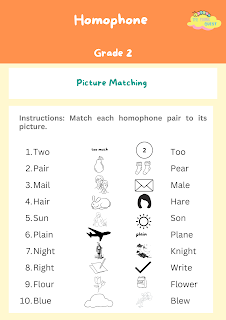Understanding and Practicing Homophones for Grades 2 & 3
Mastering homophones is an essential part of developing strong language skills in young learners. Homophones are words that sound alike but have different meanings and spellings, such as “sea” and “see” or “right” and “write.” Homophones can be tricky for children, but with engaging worksheets specifically designed for Grades 2 and 3, students can learn to differentiate and use homophones accurately.
Our homophone worksheets are designed to make learning this concept both fun and effective. Through activities like matching, fill-in-the-blank, sentence correction, and mini-stories, these worksheets help students build their vocabulary, spelling, and reading comprehension skills. The variety of exercises ensures that students not only recognize homophones but also understand their meanings and contexts.
Why Learning Homophones Matters
For young learners, understanding homophones helps them improve spelling accuracy and sentence meaning. Choosing the wrong homophone can change the meaning of a sentence entirely, like “I’ll meet you at the beach” versus “I’ll meat you at the beach.” With guided practice, students learn to select the correct homophone, enhancing their reading and writing clarity.
Types of Homophone Worksheets for Grades 2
Here’s an overview of the activities we include in these worksheets:
Fill-in-the-Blanks: These exercises offer sentences where students must choose the correct homophone from a pair, such as “flower/flour” or “knew/new,” allowing them to apply homophones in context.
Sentence Correction: Students identify and correct sentences that have the incorrect homophones, helping them practice spotting errors.
Matching Exercises: This activity reinforces their recognition by pairing each homophone with its match, making learning more visual.
These homophone worksheets not only help with vocabulary and spelling but also encourage critical thinking. When students regularly practice homophones, they develop attention to detail, stronger reading comprehension, and writing skills. They also become more confident in navigating the complexities of language, as they start to recognize which homophones to use in various contexts.
Whether used in the classroom or at home, these worksheets are valuable resources that make learning homophones an enjoyable experience. Encourage your young learners to explore and master the fun world of homophones today!
